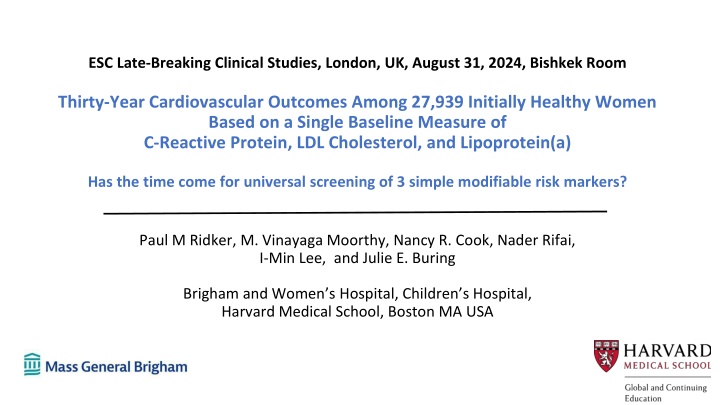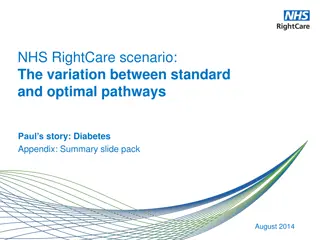
Baseline Biomarkers for Long-term Cardiovascular Risk Prediction in Women
Explore the potential of baseline measures of hsCRP, LDL-C, and Lp(a) in predicting cardiovascular risk over a 30-year period in initially healthy women. This study, conducted on a cohort of 27,939 women, examines the individual and combined effects of these biomarkers on cardiovascular outcomes. The findings shed light on the importance of modifiable risk markers in preventive cardiology and long-term cardiovascular health management.
Download Presentation

Please find below an Image/Link to download the presentation.
The content on the website is provided AS IS for your information and personal use only. It may not be sold, licensed, or shared on other websites without obtaining consent from the author. If you encounter any issues during the download, it is possible that the publisher has removed the file from their server.
You are allowed to download the files provided on this website for personal or commercial use, subject to the condition that they are used lawfully. All files are the property of their respective owners.
The content on the website is provided AS IS for your information and personal use only. It may not be sold, licensed, or shared on other websites without obtaining consent from the author.
E N D
Presentation Transcript
ESC Late-Breaking Clinical Studies, London, UK, August 31, 2024, Bishkek Room Thirty-Year Cardiovascular Outcomes Among 27,939 Initially Healthy Women Based on a Single Baseline Measure of C-Reactive Protein, LDL Cholesterol, and Lipoprotein(a) Has the time come for universal screening of 3 simple modifiable risk markers? Paul M Ridker, M. Vinayaga Moorthy, Nancy R. Cook, Nader Rifai, I-Min Lee, and Julie E. Buring Brigham and Women s Hospital, Children s Hospital, Harvard Medical School, Boston MA USA
Introduction : Why Focus on long-term risk for hsCRP, LDL-C, and Lp(a) in women? Modifiable blood biomarkers such as hsCRP, LDL-C, and Lp(a) can be instrumental for understanding biology, predicting risk, and targeting cardiovascular interventions. Reflecting completed and ongoing trials, guidelines for primary and secondary prevention are shifting to include greater focus on modifiable risk markers including hsCRP, LDL-C, and Lp(a) which predict short-term risk among individuals taking and not taking statin therapy. However, data are scarce on the long term (25 to 30 year) risks associated with these biomarkers when used alone and in combination, particularly among women for whom cardiovascular disease remains under-diagnosed and under-treated. As atherosclerosis develops over decades, these issues are a major concern for preventive cardiology and for the selection of pharmacologic and wellness interventions.
Hypothesis and Methods We hypothesized that a single baseline measure of hsCRP, LDL-C, and Lp(a) obtained in mid-life could predict future cardiovascular risk in women over a 30-year period, and that combined use of these three modifiable biomarkers could provide greater information on risk compared to any one biomarker used alone. We addressed these issues in the NIH-funded*Women s Health Study (WHS)1,2,a prospective cohort of 27,939 initially healthy American women who had all three biomarkers measured in a blood sample obtained at baseline and who have been followed by our research group for a period of 30 years for the primary endpoint of first major cardiovascular events (inclusive of centrally adjudicated incident myocardial infarction, coronary revascularization procedures, ischemic stroke, and cardiovascular death). HL043851, HL080467, and HL099355, CA047988 and CA182913 1. 2. NEJM 2005;352:1293-1304 JAMA 2005;294:56-65
Biomarker Assays and Statistical Analysis Plan All biomarkers assayed in a certified academic core laboratory at the Harvard Medical School. hsCRP : validated high sensitivity assay (Denka Seikan) LDL-C : validated direct method (Roche Diagnostics) Lp(a) : validated assay independent of apo(a) isoform size (Denka Seikan) 30-year Hazard Ratios (HR) for incident CV events were assessed across increasing quintiles of each biomarker in cause-specific Cox proportional models, adjusted for age, smoking, diabetes, blood pressure, eGFR, use of HRT, and body mass index. 30-year cumulative incidence curves adjusted for age and the competing risks of death were constructed for each biomarker using cause-specific Cox modeling. To assess for potential joint effects between any two biomarkers, covariable adjusted analyses were conducted assessing event rates according to whether paired baseline biomarker levels were above or below clinically relevant thresholds for each biomarker. To assess for potential combined effects of all three biomarkers, analysis were repeated after classifying participants based upon having 0, 1, 2, or 3 levels of baseline hsCRP, LDL-C, or Lp(a) in the top quintile.
Womens Health Study: Baseline Characteristics and Biomarker Distributions 27,939 women with no prior history of cardiovascular disease Mean age 54.7 years Mean Body Mass Index 25.9 kg/m2 Hypertension 25 %, Current Smoker 12 %, Diabetes 2.5 % Quintile 1 Quintile 2 Quintile 3 Quintile 4 Quintile 5 hsCRP (mg/L) < 0.7 0.7 1.4 1.5 2.8 2.8 5.1 > 5.1 LDL-C (mg/dL) < 96 96 113 114 129 130 - 150 > 150 Lp(a) (mg/dL) < 4 4 8 8 15 15 44 > 44 Minimal correlation between biomarkers: Spearman correlation coefficients all < 0.2 Ridker PM et al, NEJM (August 31, 2024)
30-Year Covariable Adjusted*Hazard ratios (HR) for First Major Adverse Cardiovascular Events in 27,939 Initially Healthy American Women According to Baseline Quintile of Lp(a), LDL-C, and hsCRP 2 HR*5thvs 1stQuintile (95%CI) *HR adjusted for age, smoking status, diabetes, blood pressure, eGFR, HRT use, and BMI Lp(a) LDL-C hsCRP 1.33 (1.21-1.47) 1.36 (1.23-1.52) 1.70 (1.52-1.90) Adjusted HR* 1.5 HR*per Quintile (95%CI) Lp(a) LDL-C hsCRP 1.06 (1.03-1.08) 1.08 (1.05-1.10) 1.14 (1.11-1.17) 1 HR*per St. Dev. (95%CI) 0.5 Lp(a) LDL-C hsCRP 1.09 (1.05-1.13) 1.10 (1.06-1.14) 1.23 (1.18-1.27) Quintile 1 Quintile 2 Quintile 3 Quintiile 4 Quintile 5 Lp(a) LDL-C Ridker PM et al, NEJM (August 31, 2024)
30-Year Age and Competing Risk Adjusted Cumulative Incidence of First Major Adverse Cardiovascular Events in 27,939 Initially Healthy American Women According to Baseline Quintile of hsCRP Q5 (> 5.1 mg/L) hsCR P Q4 (2.8 5.1 mg/L) Q3 (1.5 2.7 mg/L) Q2 (0.7 1.4 mg/L) Q1 (< 0.7 mg/L) Quintile (range) Years Ridker PM et al, NEJM (August 31, 2024)
30-Year Age and Competing Risk Adjusted Cumulative Incidence of First Major Adverse Cardiovascular Events in 27,939 Initially Healthy American Women According to Baseline Quintile of hsCRP Q5 (> 5.1 mg/L) hsCR P Q4 (2.8 5.1 mg/L) Q3 (1.5 2.7 mg/L) Q2 (0.7 1.4 mg/L) Q1 (< 0.7 mg/L) Quintile (range) Years Ridker PM et al, NEJM (August 31, 2024)
30-Year Age and Competing Risk Adjusted Cumulative Incidence of First Major Adverse Cardiovascular Events in 27,939 Initially Healthy American Women According to Baseline Quintile of hsCRP Q5 (> 5.1 mg/L) hsCR P Q4 (2.8 5.1 mg/L) Q3 (1.5 2.7 mg/L) Q2 (0.7 1.4 mg/L) Q1 (< 0.7 mg/L) Quintile (range) Years Ridker PM et al, NEJM (August 31, 2024)
30-Year Age and Competing Risk Adjusted Cumulative Incidence of First Major Adverse Cardiovascular Events in 27,939 Initially Healthy American Women According to Baseline Quintile of LDL-C LDL- C Q5 (> 150 mg/dL) Q4 (130 150 mg/dL) Q3 (114 - 129 mg/dL) Q2 (96 - 113 mg/dL) Q1 (< 96 mg/dL) Quintile (range) Years Ridker PM et al, NEJM (August 31, 2024)
30-Year Covariable Adjusted*Hazard Ratios (HR) and Cumulative Incidence for First Major Adverse Cardiovascular Events in 27,939 Initially Healthy American Women According to Baseline Quintile of LDL-C and hsCRP LDL-C hsCRP HR* per SD 1.10 (95%CI 1.06- 1.14) HR* per SD 1.23 (95%CI 1.18- 1.27) Q5 (> 150 mg/dL) Q4 (130 150 mg/dL) Q3 (114 - 129 mg/dL) Q2 (96 - 113 mg/dL) Q1 (< 96 mg/dL) Q5 (> 5.1 mg/L) Q4 (2.8 5.1 mg/L) Q3 (1.5 2.7 mg/L) Q2 (0.7 1.4 mg/L) Q1 (< 0.7 mg/L) Years Years *HR adjusted for age, treatment assignment, smoking status, diabetes, blood pressure, eGFR, HRT use, and BMI Ridker PM et al, NEJM (August 31, 2024)
30-Year Age and Competing Risk Adjusted Cumulative Incidence of First Major Adverse Cardiovascular Events in 27,939 Initially Healthy American Women According to Baseline Quintile of Lp(a) Lp(a ) HR* per SD 1.09 (95%CI 1.05-1.13) Q5 (> 44 mg/dL) Q4 (15 - 44 mg/dL) Q3 (8 - 15 mg/dL) Q2 (4 - 8 mg/dL) Q1 (< 4 mg/dL) Quintile (range) Years Years Ridker PM et al, NEJM (August 31, 2024)
30-Year Age and Competing Risk Adjusted Cumulative Incidence of First Major Adverse Cardiovascular Events in 27,939 Initially Healthy American Women Joint Effects of hsCRP and LDL-C hsCRP above or below 2 mg/L LDL-C above or below 130 mg/dL High hsCRP, High LDL-C High hsCRP, Low LDL-C Low hsCRP, High LDL-C Low hsCRP, Low LDL-C Years Years Ridker PM et al, NEJM (August 31, 2024)
30-Year Age and Competing Risk Adjusted Cumulative Incidence of First Major Adverse Cardiovascular Events in 27,939 Initially Healthy American Women Joint Effects of hsCRP and Lp(a) hsCRP above or below 2 mg/L Lp(a) above or below 40 mg/dL High hsCRP, High Lp(a) High hsCRP, Low Lp(a) Low hsCRP, High Lp(a) Low hsCRP, Low Lp(a) Ridker PM et al, NEJM (August 31, 2024) Years Years
30-Year Age and Competing Risk Adjusted Cumulative Incidence of First Major Adverse Cardiovascular Events in 27,939 Initially Healthy American Women Joint Effects of LDL-C and Lp(a) LDL-C above or below 130 mg/dL Lp(a) above or below 40 mg/dL High LDL-C, High Lp(a) High LDL-C, Low Lp(a) Low LDL-C, High Lp(a) Low LDL-C, Low Lp(a) Years Years Ridker PM et al, NEJM (August 31, 2024)
30-Year Age and Competing Risk Adjusted Cumulative Incidence of Coronary Heart Disease Events in 27,939 Initially Healthy American Women Combined Effects of hsCRP, LDL-C, and Lp(a) Coronary Heart Disease Events 3 Elevated Biomarkers (HR 3.7, 95%CI 2.9-4.7) 2 Elevated Biomarkers 1 Elevated Biomarker 0 Elevated Biomarkers Number of Biomarkers in the Top Quintile Years Years Ridker PM et al, NEJM (August 31, 2024)
30-Year Age and Competing Risk Adjusted Cumulative Incidence of Ischemic Stroke Events in 27,939 Initially Healthy American Women Combined Effects of hsCRP, LDL-C, and Lp(a) 3 Elevated Biomarkers (HR 1.7, 95%CI 1.1-2.5) Ischemic Stroke Events 2 Elevated Biomarkers 1 Elevated Biomarker 0 Elevated Biomarkers Number of Biomarkers in the Top Quintile Years Years Ridker PM et al, NEJM (August 31, 2024)
Additional Findings While hsCRP was the stronger predictor than LDL-C or Lp(a), the greatest spread in risk was obtained in models that incorporated all three biomarkers which were fully independent of each other. All findings were consistent for the individual endpoints of coronary heart disease and stroke. All findings were similar in sensitivity analyses that censored participant follow-up time if statin therapy was initiated. Effects marginally attenuated over time for hsCRP and LDL-C, with no attenuation for Lp(a).
Summary A single combined measure of hsCRP, LDL-C, and Lp(a) among initially healthy American women was predictive of incident cardiovascular events over a 30-year period. As each of these three biomarkers is modifiable through either lifestyle and/or pharmacologic interventions, these data support efforts to extend strategies for the primary prevention of atherosclerotic disease well beyond traditional 10-year estimates of risk.
Implications for Patient Care, Guidelines, and Public Health We can t treat what we don t measure While imaging tests can tell us who to treat, measurement of hsCRP, LDL-C, and Lp(a) can tell us what to treat with. We need to focus on lifelong risk and lifelong interventions, not simply 5-to-10-year risks and 5-to-10-year interventions. We need to focus on prevention among younger women for whom CVD remains underdiagnosed and undertreated. Given the remarkable consistency of these primary prevention data with prior cohorts inclusive of more than 45,000 contemporary secondary prevention patients1,2, we believe the time has come for universal screening of 3 simple modifiable cardiovascular risk factors: hsCRP, LDL-C, and Lp(a) 1Lancet 2023;401:1293-1301 2Circulation 2024;1149:28-35






















